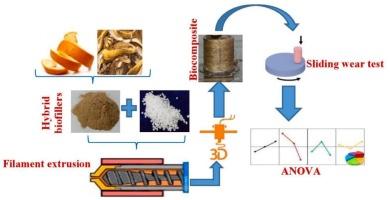Synergy of fruit wastes derived hybrid biofillers and PLA on tribological response of 3D printed biocomposite: A comparative study and parametric optimization by Taguchi design of experiment
IF 4.6
3区 材料科学
Q2 MATERIALS SCIENCE, MULTIDISCIPLINARY
引用次数: 0
Abstract
The present work was sought to develop an additively manufactured biocomposite by utilizing a biodegradable polymer namely, polylactic acid in 95 wt.% and fruit wastes derived hybrid biofillers composed of banana peel powder and orange peel powder in 2.5 and 2.5 (wt.%), respectively for tribological applications. Two-body sliding wear performance of the developed biocomposite for a Taguchi-designed experiment by considering four (04) different wear parameters were performed. The combination of the parameters that minimizes the specific wear rate was the normal load, sliding distance, sliding velocity and emery grade of 10 N, 500 m, 3 m/s and 150, respectively giving a minimum specific wear rate of 0.03426 × 10−6 mm3/N-m. The identified suitable parameters can effectively reduce the specific wear rate of the biocomposite up to 89.91 %. The observations of the worn-out surfaces have revealed the deformation of the matrix, debonding of fillers, micro-cutting, etc., as the wear mechanism.

水果废弃物杂化生物填料与聚乳酸对3D打印生物复合材料摩擦学响应的协同作用:比较研究及田口实验设计参数优化
目前的工作旨在开发一种添加剂制造的生物复合材料,利用可生物降解的聚合物,即95重量%的聚乳酸和水果废物衍生的混合生物填料,分别由2.5重量%的香蕉皮粉和2.5重量%的橘子皮粉组成,用于摩擦学应用。采用taguchi设计的两体滑动磨损实验,对所开发的生物复合材料进行了四(04)种不同磨损参数的测试。使比磨损率最小的参数组合为正常载荷、滑动距离、滑动速度和金刚砂等级分别为10 N、500 m、3 m/s和150,最小比磨损率为0.03426 × 10−6 mm3/N-m。所确定的合适参数可有效降低生物复合材料的比磨损率达89.91%。通过对磨损表面的观察,揭示了基体变形、填料脱粘、微切削等磨损机理。
本文章由计算机程序翻译,如有差异,请以英文原文为准。
求助全文
约1分钟内获得全文
求助全文
来源期刊

Materials Science and Engineering: B
工程技术-材料科学:综合
CiteScore
5.60
自引率
2.80%
发文量
481
审稿时长
3.5 months
期刊介绍:
The journal provides an international medium for the publication of theoretical and experimental studies and reviews related to the electronic, electrochemical, ionic, magnetic, optical, and biosensing properties of solid state materials in bulk, thin film and particulate forms. Papers dealing with synthesis, processing, characterization, structure, physical properties and computational aspects of nano-crystalline, crystalline, amorphous and glassy forms of ceramics, semiconductors, layered insertion compounds, low-dimensional compounds and systems, fast-ion conductors, polymers and dielectrics are viewed as suitable for publication. Articles focused on nano-structured aspects of these advanced solid-state materials will also be considered suitable.
 求助内容:
求助内容: 应助结果提醒方式:
应助结果提醒方式:


